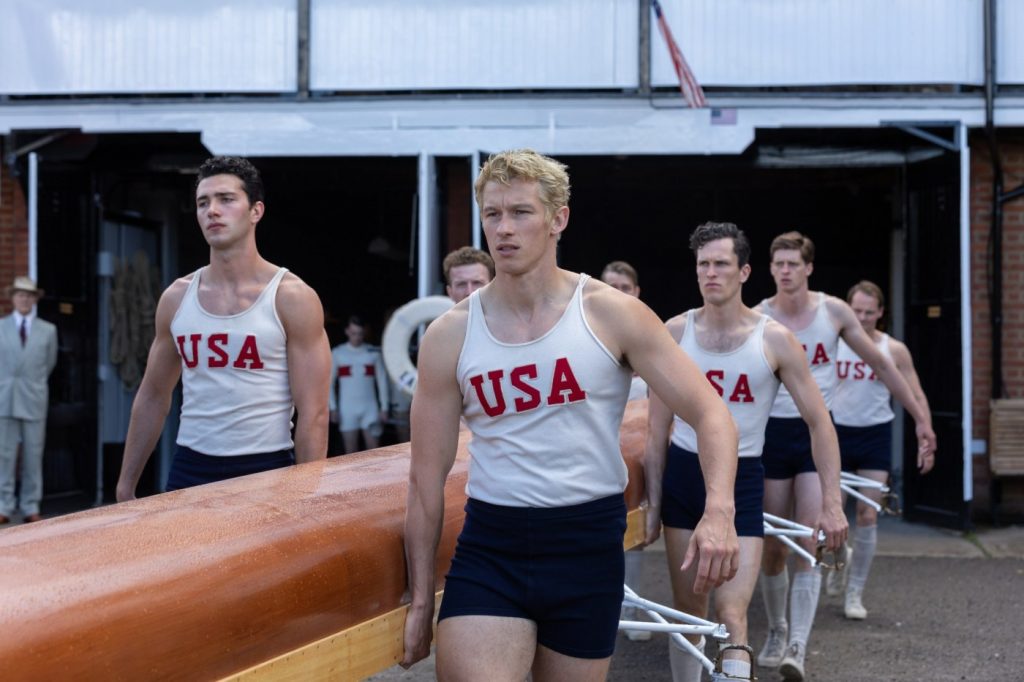When Joe Rantz was four years old, his mother died.
While Rantz was still a teen, his father and stepmother, viewing him as one extra mouth to feed, abandoned him at the start of the Great Depression. But Rantz persevered, living in an unfinished house and making his way through high school and to the University of Washington, where he studied engineering. Needing money for his tuition, Rantz learned he could earn enough and gain a place to live if he could make the school’s crew team.
Although he’d never rowed before, Rantz made the team and was a crucial member of an underdog squad that not only won national titles but also earned a gold medal in Berlin at the 1936 Olympics – stunning Adolf Hitler and the world.
The story, which is based on Daniel James Brown’s nonfiction bestseller of the same name, provides the basis for George Clooney’s latest film, “The Boys in the Boat,” a story of American grit and perseverance against overwhelming odds, which goes wide in theaters on December 25. For his leading man, Clooney tapped Callum Turner, a British actor best known here for the “Fantastic Beasts” films.
Turner, 33, spoke by video recently about learning to row and how it connected to his acting. This interview has been edited for length and clarity.
Q. How did you get the part?
It was pretty straightforward. I sent off a tape to George and Grant [producer Grant Heslov], and then we got on Skype. We talked for 20 minutes and then I did one of the scenes. And because I’m an actor I asked, “Oh, can I do that again?”
And George said, “Can I just tell you one thing? You’ve got the part. We were just seeing if we like you, if you’re a cool guy …” That was a nice little moment for sure.
Q. How much of the appeal of this was the script and the role and how much of it was Clooney?
He’s an amazing director and I’ve always wanted to work with him. Also, he doesn’t like me saying this, but he’s my favorite Batman. That was the one that I grew up on. So George was the first port of call.
Secondly, I’ve always wanted to do a sports movie, and I was 31 when I got the call for this, and I thought, “I’m running out of time. I don’t know anything about rowing, but I’m going to throw myself in.”
Q. How much research did you do into growing up in the Great Depression?
What was remarkable about Joe is that he did it all by himself. He had to fish for salmon to survive. What he was able to do to survive is so inspiring. I tried immersing myself in the time and people like Gary Cooper in “High Noon” — I love that movie — were a big inspiration because of his stoicism.
Woody Guthrie’s music became really important; as a ritual, I would listen to him every morning before I went out to film, especially “This Land is Your Land.” And Guthrie was always on the move, like Joe so that resonated for me.
Q. We see Joe stuffing newspaper into his shoes to cover the holes. Were the props or clothes important to finding your way to the time and his character?
Those shoes were hard and worn and so were the jeans so it’s all the details together. It’s the cocktail of the music and his cadence and the way he walks. And then since Joe has trust issues, I tried to distance myself a little bit at first from the others so I had somewhere to go on Joe’s journey of trust and opening up and so at the end, I felt so part of the team.
I just filmed “Masters of the Air” [a World War II miniseries] and every time you’d go up in a plane you knew you might not come back. So I built this friction between me and the plane. I’d always be the last person to get in the plane because I just didn’t want to get in it.
Q. How much training did you do to prep for the rowing?
Before we started shooting, I had a month of prep myself and then we did two months straight, four hours a day on the water. It was excruciating, but we were a team.
It would have been difficult enough if there were seven skilled rowers in the boat with me. But none of us knew how to do it so there’s eight individuals trying to learn the same skill for the first time, which created its own problem. But George and Grant, they set us up to succeed. They gave us everything we needed. They gave us nutritionists and physios and personal trainers, and we just threw ourselves into it.
Everyone was so committed and determined to achieve the 46 strokes per minute, which was our target at the beginning. That spurred us on.
Q. Did the frustrations of trying to find that rhythm and the physical exhaustion help you connect to your character?
Absolutely. And there is no other way of doing this movie. We had to know what that experience was. We had to be able to do it on camera, and so we had to go through it. There was no hiding.
I think that’s symbolic of rowing. You have to be a cog in a system – if your hands aren’t the same height, if you’re not pressing your foot with the same amount of pressure as everyone else, the boat goes slower. So you have to be in unison.
Related Articles
More than 100 Bay Area festivals and fairs are on deck for 2024
Tom Wilkinson, star of ‘The Full Monty’ and ‘Michael Clayton,’ has died
With sports movies an endangered species, a look back at memorable offerings of decades past
Pierce Brosnan faces federal charges after allegedly trespassing in ‘delicate’ Yellowstone hot spring
Lee Sun-kyun is 5th Korean star to die of suspected suicide; 12 have perished in tragedies in recent years
That’s completely different from other sports where a star player can win you the game with moments of brilliance. This is almost like army-like marching, but that hardship and that structure only makes it more special.
You really have to merge together, to blend into one. It was so profound, it was spiritual.
Q. What did it feel like when you got to 46 per minute?
Well, the journey was the destination. We learned, which was frustrating, but we learned from each other. There were so many moments where 46 strokes felt so out of reach. In the last race, we got there and there was this euphoria in the boat, but there was also this feeling of disbelief.
A couple of days later, we rode back to the boathouse from a kilometer away and no one said it, but we realized that this was the last row we were going to have, and we rode in silence. It was really special.


